Guest Editorial:
Building Compassion From the Ground Up
How Kids Can Help Animals by Being Responsible Guardians
By Bruce Zeman, Jr.
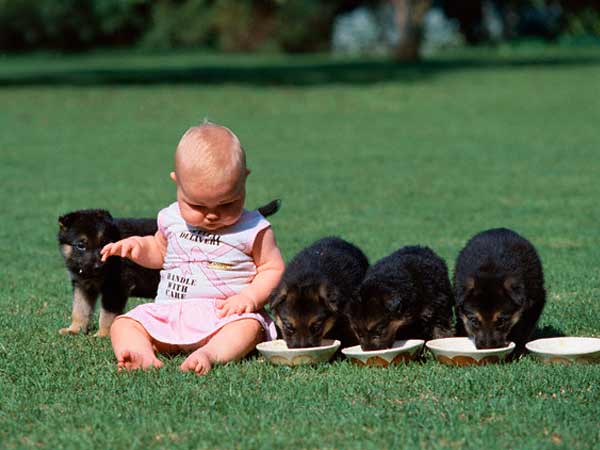
Change is coming, and for the animals, it can’t happen soon enough.
Whether it’s the 8-10 million perfectly adoptable animals euthanized in the United States each year, the 660,000 slaughtered for food every hour, or the appalling cases of cruelty where perpetrators get little more than a slap on the wrist, the time has come to change the way we speak about, and perceive, non-human animals. Animal rights and welfare organizations have existed for years, and yet even today, one of the most daunting challenges remains how to alter perceptions. The question remains, “How can our vision of animals transcend the antiquated view of treating them as “things” or “commodities” rather than sentient beings, with needs and complex emotional and intellectual lives of their own?
Part of the solution rests in countering the archaic and incorrect assumption that animals are non-thinking, non-feeling objects to be used, exploited and objectified. The remainder of the solution, more than likely, lies within each of us - if we are willing to look at ourselves, and change our own behaviors. Humans are but one species on the planet, and our mere presence by no means entitles us to unquestioned superiority. The time has come for change - in actions, thoughts and language. The time has come for a paradigm shift with respect to ending stereotypes and human authority over another species. History is providing us with an unmistakable call to action - to create a moral and ethical imperative embracing our responsibility for, and towards, animals.
Education - The Prescription for Change
Throughout history, education and semantics have played a vital role in every social movement, and the growing push for animal rights is no 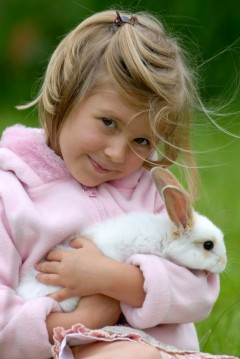 different. It was not long ago African Americans, women and children were regarded as property. In the case of animals, altering the way humans speak of (and view them) is even more critical. Animals cannot speak for or defend themselves, and must rely on those who believe there is a moral, ethical and legal obligation to protect them from abuse, exploitation and neglect - members of one species protecting the rights and well-being of another.
different. It was not long ago African Americans, women and children were regarded as property. In the case of animals, altering the way humans speak of (and view them) is even more critical. Animals cannot speak for or defend themselves, and must rely on those who believe there is a moral, ethical and legal obligation to protect them from abuse, exploitation and neglect - members of one species protecting the rights and well-being of another.
In Defense of Animals (IDA), an international animal protection organization based in California, whose singular mission is to protect the rights, welfare and habitats of animals worldwide, has worked tirelessly for over 25 years to end animal exploitation, cruelty and abuse. In 1999, IDA launched the “Guardian Campaign,” to elevate the status of animals above mere property, commodities or things, by changing perceptions of animals through subtle, but critical change in language. In the past, animals had legal standing as commodities or property, and often their exploitation, neglect or abuse was ignored, rationalized, and even justified. At the dawn of the 21st century, IDA and its visionary founder, Dr. Elliot Katz, DVM, set out to revolutionize those views.
The “Guardian Campaign” was created to reflect growing public support for a redefined public standard of relating to animals. With animal-companions taking an ever-increasing, and more important, role in families, more and more people began to refer to themselves as “guardians,” instead of “owners,” recognizing the deep personal relationships humans develop with non-human animals. Replacing the term “owner” with “guardian” may seem like an insignificant play on words, something trivial, but history has shown that movements are spearheaded by words, and this very change in semantics can stir people to action, and alter history.
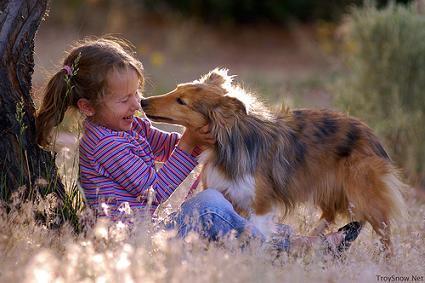 Since 2000, when Boulder, Colorado, became the first “Guardian City,” the campaign has spread across North America with the realization it was time to embrace the powerful idea that we respect and honor animal lives as distinctly their own, as well as acknowledging the profound bond that exists between humans and their animal companions. Currently, almost 6 million Americans and Canadians are officially recognized as “guardians,” and the number is growing. In cities across North America, state and local governments, community groups, and schools, along with child and animal welfare organizations, are adopting “guardian language” since it is a more accurate representation of the connection between people and their animal companions.
Since 2000, when Boulder, Colorado, became the first “Guardian City,” the campaign has spread across North America with the realization it was time to embrace the powerful idea that we respect and honor animal lives as distinctly their own, as well as acknowledging the profound bond that exists between humans and their animal companions. Currently, almost 6 million Americans and Canadians are officially recognized as “guardians,” and the number is growing. In cities across North America, state and local governments, community groups, and schools, along with child and animal welfare organizations, are adopting “guardian language” since it is a more accurate representation of the connection between people and their animal companions.
Guardians - Why Words Matter
Here are a few of the benefits “guardians” bring to their communities and the animals who live there:
Guardians Recognize Animals as Individuals, Not Objects Making a conscious effort to use the term “guardian” instead of “owner,” imprints upon a community’s consciousness the importance of animals. By viewing, treating and speaking about animals from the perspective of a “guardian,” a person demonstrates that he or she respects and recognizes animals as individuals with needs and interests of their own.
Guardians Recognize Changing Public Attitudes
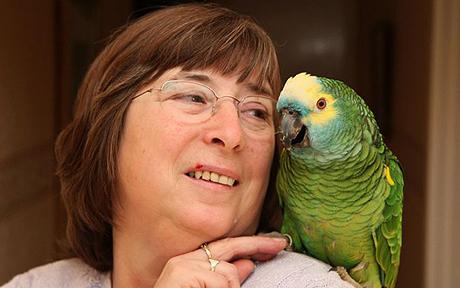 Society’s changing attitudes toward animals is reflected in language people use to write and speak about them. Numerous studies indicate the majority of people living with animal companions see them as family members. Using the term, “guardian” exudes respect. Adults, using the term, set an example to help children appreciate dogs, cats and other animals as living creatures who depend on us for care and protection.
Society’s changing attitudes toward animals is reflected in language people use to write and speak about them. Numerous studies indicate the majority of people living with animal companions see them as family members. Using the term, “guardian” exudes respect. Adults, using the term, set an example to help children appreciate dogs, cats and other animals as living creatures who depend on us for care and protection.
Guardians Reduce the Number of Animals in Puppy Mills
Most animals sold in pet stores come from puppy mills. Every animal purchased equals one euthanized at a shelter or humane society. Buying that adorable puppy or kitten seen in the pet shop window, directly affects the tragic over-population problem by taking a potential home away from an animal about to be euthanized in a shelter. Buying an animal also funds puppy mills, and contributes to the perception of animals as marketable commodities. When someone says he or she “owns” animals, it encourages others to see these “owned” animals as having only monetary value. When people call themselves a “guardian,” they communicate the emotional value of animals.
Guardians Help Decrease Abuse and Abandonment
Adults have the opportunity to teach young people that being a “guardian” is a valued personal characteristic. When adults lead by example, children will be less likely to abuse or abandon their animal companions. When adoption agencies, shelters, and rescue organizations work with the community to reinforce the idea of being a “guardian,” people in the community will far more likely feel they are adding a family member, as opposed to purchasing a disposable piece of property.
Guardians Positively Impact Local Communities
It is a community-based effort to legally recognize citizens as “guardians.” A community of “guardians,” working together, can have a positive impact on animal issues facing the municipality, such as shelter overpopulation, barking dogs, dog fighting and animal abuse. Calling residents “guardians” empowers communities to work together toward common solutions. Updating a community’s codes to include the term “guardian” is a symbolic change demonstrating a new attitude of public concern for animal welfare. Though updated legal language does not affect one’s legal rights, responsibilities, or liabilities, the psychological and sociological impact of the language change helps advance positive and encouraging views toward animals and their care.
Changing people’s perceptions about animals won’t happen overnight, but it will happen. The key to facilitating such change lies in humane education and fostering an awareness that animals exist for their own reasons, not simply to benefit humans. Many open-minded and compassionate adults have already embraced the idea of being a “guardian” instead of an “owner,” but the impetus for permanent change lies in educating future generations about animals, and our responsibilities to them. Children must be empowered to make the world a better, more compassionate place. Once these children become adults, they will pass on experiences to their kids, and so on. The cycle of compassion needs to begin now. With the right educational support and parental reinforcement, it can and will perpetuate itself.
Remember - one person can make a difference! Be part of the solution, not the problem.
© 2009 Bruce Zeman
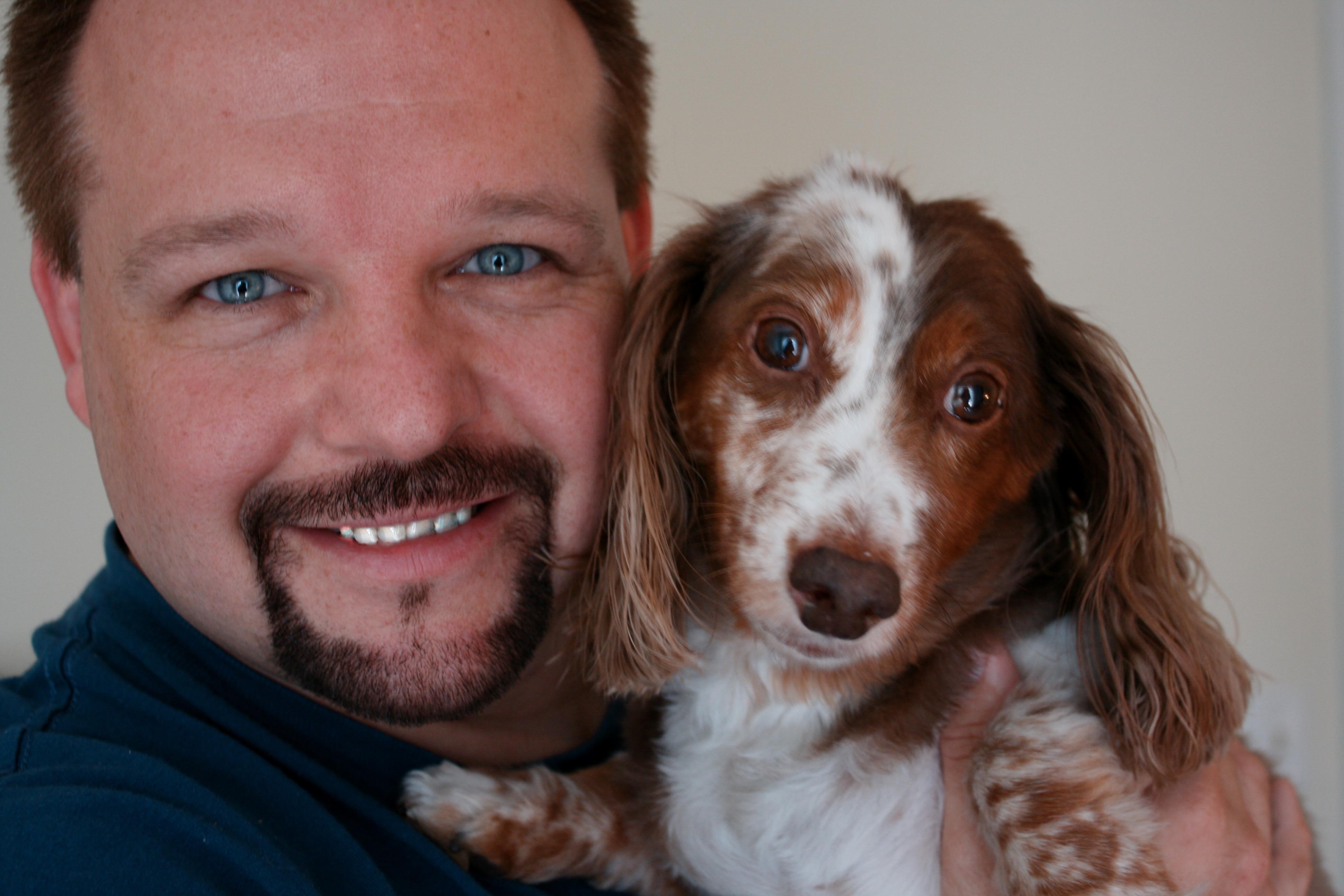
Bruce Zeman brought a lawsuit against his former apartment landlord on behalf of his family and twenty other tenants of the building to enable them to keep their companion animals. After winning the suit, he went on to campaign in his city, Wanaque, New Jersey, to change the language of city ordinances from "pet owners" to "guardians." In 2004, Wanaque became the first "Guardian City" in New Jersey, and the new law was called "Nathan's Law" after Bruce's dog friend (see above). As active participants in IDA's Guardian Campaign, Bruce and Nathan make presentations to school children to raise consciousness about respect for animals. Bruce also deals with animal issues extensively on the radio show he hosts.
This essay is part of a longer one Bruce is publishing in pamphlet form.
Unset Gems
 "The history of the world, my sweet,
"The history of the world, my sweet,
Is who gets eaten and who gets to eat."
--Hugh Wheeler / Stephen Sondheim, Sweeney Todd
The story of Sweeney Todd, originally from a Victorian melodrama, deals with serial murder covered up by profit-making cannibalism.
"If by some miracle, and all our struggle, the earth is spared, only justice to every living thing (and everything is alive) will save humankind.
Only justice can stop a curse."
--Alice Walker
News Notes
Cow Tail Mutilation Ended in California
Cows in California can no longer be routinely tail-docked. The Governor of California signed into law SB 135 which bans these callous amputations. Thanks to all those who helped by supporting this campaign.
--Contributed by Animal Place Sanctuary
Michigan to Ban Gestation Crates
Michigan has become the seventh state to ban gestation crates, the fifth to ban veal crates, and the second to ban battery cages. Michigan's governor Jennifer Granholm signed HB 5127, which will phase out veal crates for calves within three years, battery cages for laying hens and gestation crates for breeding sows within ten years. To read the full article see Crate Ban .
--Contributed by Lorena Mucke
Good News from Ireland
Fur farming will end in Ireland in three years' time, thanks to the Green Party Programme for Government; the Environment Minister, John Gormley, is a Green. In addition to this ban, there will be an end to stag hunting after March 2010, and the ending of badger culling when a vaccine against bovine TB is found. New animal welfare legislation is also promised.
Animal defense groups in Ireland and the United Kingdom have welcomed this programme. CAFT Ireland (Coalition to Abolish the Fur Trade) said that its greatest goal had been achieved by the Green Party and it would now turn its attention to banning fur imports.
After several years of lobbying and reminding the minister that a ban on blood sports is in the Green Party manifesto, Quaker Concern for Animals congratulates Mr. Gormley and all campaigners for this major victory. However, foxes and hares still desperately need his protection.
--Contributed by Marian Hussenbux
Letters
Dear Peaceable Friends,
. . . . I grew up in Iowa. In those days the farmers raised corn, and the huge agricultural corporations had not yet taken over. When they appeared, they lured farmers to grow soy with larger profits, but eventually the corporations took over, and family farms declined. Now more soybeans are grown in Iowa than corn.
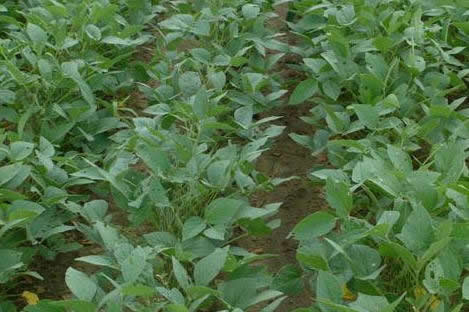 Soybeans are more versatile and are found in some form in many products besides food. Some soy-based foods are delicious, but these corporations always create much slag which goes into the worst foods imaginable. Such foods are not palatable enough for public tastes, but are marketed to institutions. Those which most institutions reject end up being sold cheaply to prisons. So we get more soy products, but they are bottom-of-the-barrel stuff, not like tasty Gardenburgers and the like. When the menu says "burger patty," which is not meat, we call it cat food. At a meal like that, sometimes fewer than half the inmates bother going to chow. . . . . Personally, I would not feed that stuff to my cat. . . .
Soybeans are more versatile and are found in some form in many products besides food. Some soy-based foods are delicious, but these corporations always create much slag which goes into the worst foods imaginable. Such foods are not palatable enough for public tastes, but are marketed to institutions. Those which most institutions reject end up being sold cheaply to prisons. So we get more soy products, but they are bottom-of-the-barrel stuff, not like tasty Gardenburgers and the like. When the menu says "burger patty," which is not meat, we call it cat food. At a meal like that, sometimes fewer than half the inmates bother going to chow. . . . . Personally, I would not feed that stuff to my cat. . . .
It saddens me that vegetarians in the US encounter hardships. I appreciate the diversity in PT, in presenting our challenges and victories.
Peace, love and joy,
Gerald Niles
Gerald, who is incarcerated in Florida, appreciates opportunities to correspond with fellow vegetarians. His address is: 122280, Tomoka Correctional Institution, 3950 Tiger Bay Rd., Daytona Beach, FL 32124.
A Glimpse of the Peaceable Kingdom
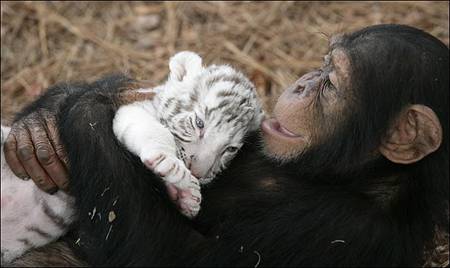
Last year, two white tiger cubs newly born at a big cat facility in South Carolina had to be separated from their mother when a hurricane swept through the area, and she became alarmed and aggressive. The babies' human caretaker received major assistance from a nurturant chimpanzee named Anjana. See Chimp Momma for further photos.
--Contributed by Barbara Booth
Book Review: Crow Planet
Lyanda Lynn Haupt, Crow Planet. New York and Boston: Little, Brown, 2009. 230 pages. $23.00 hardcover.
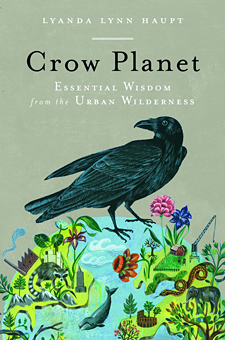 Crows, according to this author, are undoubtedly the form of wildlife seen more often by more human beings than any other. So often, in fact, that unless distracted by their raucous cawing, we may pay them little attention as we look for presumably more appealing songbirds or cuter squirrels and rabbits. But crows are there. They are found in virtually every habitat on earth, and moreover, being very intelligent and adaptable, are one of the few species that have flourished right alongside human beings, taking the role of sophisticated urbanites as readily as that of forest-dwellers. While the human tsunami has pushed innumerable species to the brink of extinction or past it, it is thought the crow population of earth has increased right along with the human, at the same rate.
Crows, according to this author, are undoubtedly the form of wildlife seen more often by more human beings than any other. So often, in fact, that unless distracted by their raucous cawing, we may pay them little attention as we look for presumably more appealing songbirds or cuter squirrels and rabbits. But crows are there. They are found in virtually every habitat on earth, and moreover, being very intelligent and adaptable, are one of the few species that have flourished right alongside human beings, taking the role of sophisticated urbanites as readily as that of forest-dwellers. While the human tsunami has pushed innumerable species to the brink of extinction or past it, it is thought the crow population of earth has increased right along with the human, at the same rate.
Surely such remarkable avians are worth a second look, and that Lyanda Lynn Haupt has given them in this elegant, informative, and wise book. She recognizes at the outset that people have very different attitudes toward the midnight-black creatures. Some like them, and are ready to come forth with their favorite crow-story: the bird invented an ingenious tool for extracting food from an inaccessible site, or intentionally misled watchers by carrying sticks for a nest to the wrong tree. Some see them as only a nuisance, with their noise, their dive-bombing of intruding cats or persons, and their ability to devastate a garden. Some find them vaguely ominous, as though associated with dark powers or harbingers of death, and won't go near them.
For Haupt, the crow-connection was profoundly healing and wisdom-imparting. Though trained as an ornithologist and a one-time worker for the Audubon Society, after she settled into a wife-and-mother role in suburban Seattle, she experienced periods of serious emptiness and depression. It was seeing and helping an injured crow in her yard that brought her out of it and, in time, give her a new purpose in life, more than amply fulfilled in this wonderful book.
Crow Planet tells enough to give one a tremendous new respect for corvids. Their problem-solving ability continually surprises the observer; for example, up-to-date with human as well as avian civilization, they have now learned to put nuts or snails on the road where cars may run over and crack the shell, enabling the bird to get at the meat. (On very busy streets with stoplights, some crows will even wait at the corner for a green light to run out and retrieve their treat.) So also does their corvid sociability surprise with its depth and complexity. They are among the few species that will support and feed a disabled bird of their family, sometimes for as long as a year, and will gather to stand quietly by one who is dying. They have a vocabulary of several dozen words at least, issuing all sorts of warnings and notices, and will assemble for meetings when that call is given. They enjoy play as well as work. They may even have an appreciation of art. Crows will make little collections of bright objects -- beads, stones, scraps of cloth, flowers -- then arrange them and look at them for no purpose discernible by humans unless akin to our enjoyment of -- or even finding profound meaning in -- works of art.
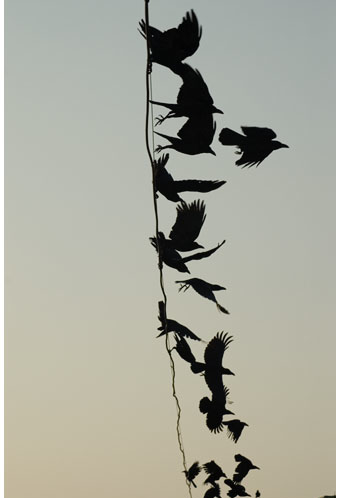
Haupt uses crows further as an entrée into wise reflections on humanity and nature: how we truly should relate to nature, and how to get humankind to take the looming ecological crisis seriously while there is still time, if there indeed is. She makes the good point that the dour sort of ecological prophet, while understandable in view of the grim news she or he has to bear, given human nature is not likely to be as effective as another sort of spokesperson for the planet. That is one who can show us how to do what she did in the company of crows: learn the joy of living with nature rather than against it, seeing ourselves as natural companions of all life on the green earth, then doing what comes freely out of this joy.
Crow Planet is a book I would really urge on all those with planetary concerns, all who love animals, all who express that love in their eating. (Haupt, incidentally, identifies herself as a vegetarian.) I do not so insist regarding all animal books, even those reviewed in The Peaceable Table, but this one is very special. Its elegance of style, its love, its joy, and its profound insight into the whole world of animals, ecology, and nature make it indispensable. Please read it, and give it to everyone on your list for Christmas or Hanukkah.
--Robert Ellwood
Film Review: Up
Up. A 2009 Pixar animated film produced by Jonas Rivera and directed by Pete Docter. Featuring Ed Asner as Carl Fredricksen, Jordan Nagai (age 7) as Russell, and Christopher Plummer as Carl Muntz. To be released on CD in November, 2009.
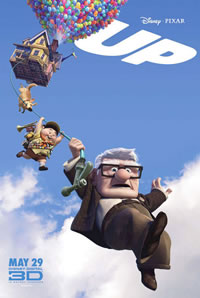 In the first quarter of an hour of this film, we see the love story of Carl, a shy little boy, and Ellie, a bold little girl, who meet during an adventure in an old house. They grow up, dreaming of becoming adventurers like the dirigible-flying Charles Muntz, inventor and explorer extraordinaire. They marry, renovate and move into the old house in which they met, and plan someday to travel to Paradise Falls in a South American jungle. They grow old together, and, poignantly, Ellie gets sick and passes away. Poor Carl is quite devastated, both from loneliness and because he feels he failed her: due to various financial obstacles, that South American adventure never took place.
In the first quarter of an hour of this film, we see the love story of Carl, a shy little boy, and Ellie, a bold little girl, who meet during an adventure in an old house. They grow up, dreaming of becoming adventurers like the dirigible-flying Charles Muntz, inventor and explorer extraordinaire. They marry, renovate and move into the old house in which they met, and plan someday to travel to Paradise Falls in a South American jungle. They grow old together, and, poignantly, Ellie gets sick and passes away. Poor Carl is quite devastated, both from loneliness and because he feels he failed her: due to various financial obstacles, that South American adventure never took place.
Persecuted by a greedy real-estate developer who covets his beloved house, Carl, who made his living selling helium balloons, ties the strings of his entire inventory to the fireplace of his house and lifts off. Very soon he discovers to his annoyance that he has a stowaway on the front porch: A Wilderness Explorer (something like a Boy Scout or Junior Woodchuck) named Russell, a roly-poly Asian-American child who had come to his door earlier, seeking an opportunity to earn a Merit Badge for Assisting the Elderly. Negotiating a storm which almost knocks out Carl's primitive steering device, by a miracle they arrive semi-safely in the South American wilderness, not far from Carl's and Ellie's long-intended destination.
Here the adventure heats up. During an exhausting trek to the falls, Russell befriends a huge beautiful prehistoric bird (whom he names Kevin, before discovering that he is a she and a mother), and faces a pack of fierce dogs who are intent on capturing this marvelous creature. The canines have all been equipped with a voice-box collar that allows them to communicate in
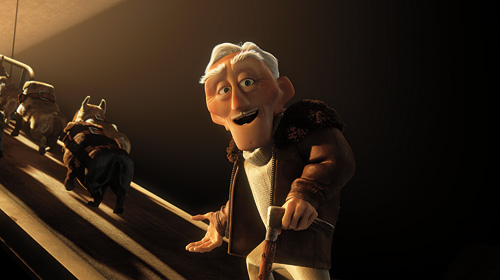
English. These devices are the invention of none other than Charles Muntz, childhood hero of Carl and Ellie, whose dirigible is parked in a nearby cave. Carl is thrilled to meet him, but the dream-come-true turns into a nightmare as we find that Muntz is a paranoid psychopath, a more ruthless Captain Ahab, totally obsessed with capturing (preferably alive, but he will settle for dead) the amazing bird, in order to prove to his long-ago detractors that his claim of having seen one was not a fraud. He has deprived the dogs of a normal canine life and sees value in them only as his slaves in the pursuit of the bird. One dog still keeps a corner of his/her own soul--though trained to serve food, he steals and eats it as soon as he has served it.
The main part of the film, which includes amusing takeoffs on the light-saber duels and space-dogfights of Star Wars, is the struggle between the cruel and ruthless Muntz, who wants the bird as a scientific trophy, and the kindly and gentle Russell, who just wants to return her to her babies. It is also a tug of war for the heart and soul of the crotchety Carl, as well as of the enslaved dogs.
Recommended for all children, and for all adults who enjoy a movie that will make them laugh and encourage them to look beneath the surface of curmudgeonly oldsters and fierce dogs for the better self within.
--Benjamin Urrutia
Recipes
Sweet Potato Bake
 6 – 8 medium sized sweet potatoes, peeled and grated
6 – 8 medium sized sweet potatoes, peeled and grated
½ - ¾ cup water
¼ cup brown sugar
2 T. Earth Balance Buttery Substitute
½ tsp. sea salt
¼ tsp. ground cinnamon
¼ tsp. ground ginger
⅛ tsp. fresh grated nutmeg
1 cup water
2 T. nutritional yeast flakes
Preheat oven 400° F.
Melt Earth Balance in a large skillet over medium heat. Add the grated sweet potatoes in a large skillet along with sea salt, brown sugar, cinnamon, ginger and nutmeg. Stir with a wooden spoon to coat sweet potatoes with Earth Balance and spices. Add water (½ - ¾ cup). Cover and let sweet potatoes cook for about 5 minutes or until softened. Stir occasionally so that the potatoes do not stick. When potatoes are softened, remove from heat. Whisk together the water and nutritional yeast. Pour over sweet potatoes in the skillet.Stir to combine well. Transfer sweet potatoes to a 9 inch deep dish pie plate, which has been coated with non-stick baking spray.
Bake at 400° F for 15 minutes to brown the top of the potato mixture. Then decrease temperature of oven to 350° F and bake for an additional 20 minutes until bubbly. Remove from oven. May be served hot or at room temperature.
This is a delicious way to serve sweet potatoes for Thanksgiving.
---- Angela Suarez
Agave Dijon Dipping Sauce
¼ cup Nayonaise (soy mayonnaise substitute)
1 T. agave nectar (Wholesome Sweeteners brand Organic Raw Blue Agave)
1 T. Dijon mustard
Whisk all ingredients together in a small bowl.
Serve with baked tofu or use on vegan deli slice sandwiches. This sauce is also delicious with roasted vegetables or appetizers.
--- Angela Suarez
Roasted Artichoke Hearts
1 package (12 oz.) frozen artichoke hearts
1 T. brown rice flour
1 T. yellow corn meal (medium grind)
2 T. chickpea flour
¼ tsp. sea salt
½ tsp. Thai seasoning powder
¼ cup plain rice or soy milk
1 T. nutritional yeast flakes
olive oil, for drizzling artichoke hearts
Preheat oven to 425° F.
Whisk together rice milk and nutritional yeast in a medium size bowl.
In a reusable container with a lid, combine flours and seasoning.
Coat artichoke hearts in rice milk-nutritional yeast mixture. Then coat with the flour mixture. It’s just like a shake ‘n’ bake, but without harming any animals. Place artichokes on a baking sheet fitted with parchment paper. Drizzle with a little extra-virgin olive oil. Bake 10 – 15 minutes until hot and crispy. Serve immediately with Agave-Dijon Dipping Sauce.
--- Angela Suarez
My Pilgrimage: Environmental Wacko
by Keith M. Folino
I'm a wacko: a minimal-consuming, animal-loving, tree-saving, recycling, ozone-protecting, population-squelching, vegetarian of the worst kind. I know this, and I rue the day that my mind started to go.
It didn't happen all at once. I can remember walking across a busy downtown street in Cleveland, Ohio long before the move to clean up Lake Erie had begun. . . . Slave to a powerful nicotine-jones, I dodged impatient traffic and stripped cellophane from the top of a new pack of Camel regulars. I peeled back the tinfoil and threw the small crumpled wad onto the sidewalk as I hopped up onto the curb.
There's no telling what triggers an "Earth Day" virus. Mine lay insidiously dormant in my heart for years before swimming slowly along my veins into the gray matter between my ears. But once the parasite awoke, there was no stopping its invasive effect. I watched that little ball of foil and plastic bounce along the sidewalk before rolling into the gutter beside a pile of litter, and the initial symptom of my disease reared its ugly head. A small light flashed behind my eyes, and I heard a whisper, the first in a never ending torrent of manic musings: "You live on this planet, Keith. Why would you want to trash it up?"
Now, years later, smart people do everything they can to avoid letting my disease contaminate their minds. They know I'm beyond hope. They smile condescendingly, as I banter about the need for them to separate their aluminum cans from their trash or the likelihood that the chicken they are preparing for their family is besieged with E-coli or salmonella.
I must be deranged! Why else would such awful thoughts course through my mind? The stench of cramped warehouses lighted seventeen hours a day. Cages stacked high from end to end, the sorry tenants, beaks seared off at birth, defecating on those below, while their feet become one with the wire floor. Seven weeks later their unnaturally plumped bodies skewered end-to-end bleeding the prized flesh that saner members of our society wait impatiently to devour in box restaurants lining the roads across our nation.
Normal people aren't troubled by what lies under the special sauce between their sesame-seed buns either. They crowd beneath the golden arches, wolfing down their food while wackos like me wonder how many acres of rain forest disappeared to provide those "billions and billions" of burgers. Why, I wonder, doesn't heating meat to a temperature calculated to kill the bacteria in it seem like a reasonable solution to me? I'm goofy! That's the only possible explanation. . . . I'm so off-balance I wouldn't only try to stop a friend from eating this fecal fare, I'd push him aside if he were getting ready to step in it.
I hear voices (more proof that I'm wacko) whispering terrible things to me! The Earth's population has doubled in twenty years while nearly a billion people are starving, and most of our grain is fed to livestock. It takes seven [-to-sixteen] pounds of precious grain . . . to produce one pound of beef. Fifty-five square feet of rain forest is slashed and burned for every quarter-pound burger imported from that region. Twenty-five percent of the Central and South American rainforest has disappeared since 1960. The number one non-point source of pollution in North America comes from livestock waste and the pesticides and fertilizers used to grow feed. Inside my disturbed dome, this kind of logic just doesn't add up.
Oh, I've tried to get normal over the years. I would hide from the other loonies every once in a while. I'd find a quiet place by myself and I would eat meat . . . . I worked hard to retrieve my sanity, but in the end, I knew I was still completely wacko. I pushed the plate of bones and gristle away, tongued a stringy piece of pig-flesh wedged between my molars, and listened to the whisper of voices at the back of my mind again: "It's your mouth, Keith. Why would you want to trash it up?"
Reprinted with permission from Voices from the Garden, edited by Sharon and Daniel Towns, Lantern Books, 2001.
Poetry: Robert Frost, 1874-1963
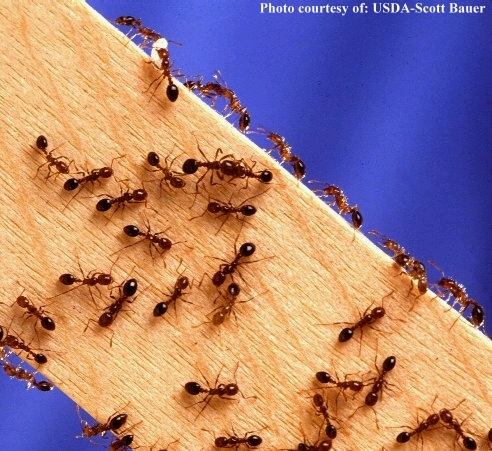
Departmental
or, My Ant Jerry
An ant on the tablecloth
Ran into a dormant moth
Of many times his size.
He showed not the least surprise.
His business wasn't with such.
He gave it scarcely a touch,
And was off on his duty run.
Yet if he encountered one
Of the hive's enquiry squad
Whose work is to find out God
And the nature of time and space,
He would put him onto the case.
Ants are a curious race;
One crossing with hurried tread
The body of one of their dead
Isn't given a moment's arrest--
Seems not even impressed.
But he no doubt reports to any
With whom he crosses antennae,
And they no doubt report
To the higher-up at court.
Then word goes forth in Formic:
"Death's come to Jerry McCormic,
Our selfless forager Jerry.
Will the special Janizary
Whose office it is to bury
The dead of the commissary
Go bring him home to his people.
Lay him in state on a sepal.
Wrap him for shroud in a petal.
Embalm him with ichor of nettle.
This is the word of your Queen."
And presently on the scene
Appears a solemn mortician;
And taking formal position,
With feelers calmly a-twiddle,
Seizes the dead by the middle,
And heaving him high in air,
Carries him out of there.
No one stands round to stare.
It is nobody else's affair.
It couldn't be called ungentle.
But how thoroughly departmental.
--1936
The Peaceable Table is
a project of the Animal Kinship Committee of Orange Grove Friends Meeting, Pasadena, California. It is intended to resume the witness of that excellent vehicle of the Friends
Vegetarian Society of North America, The Friendly
Vegetarian, which appeared quarterly between 1982 and
1995. Following its example, and sometimes borrowing from its
treasures, we publish articles for toe-in-the-water
vegetarians as well as long-term ones.
The journal is intended to be
interactive; contributions, including illustrations, are
invited for the next issue. Deadline for the December issue
will be Nov. 28, 2009. Send to graciafay@gmail.com
or 10 Krotona Hill, Ojai, CA 93023. We operate primarily
online in order to conserve trees and labor, but hard copy
is available for interested persons who are not online.
The latter are asked, if their funds permit, to donate $12 (USD) per year. Other
donations to offset the cost of advertising (in The Christian Century) are welcome.
Website: www.vegetarianfriends.net
Editor: Gracia Fay Ellwood
Book and Film Reviewers: Benjamin Urrutia & Robert Ellwood
Recipe Editor: Angela Suarez
NewsNotes Editors: Lorena Mucke and Marian Hussenbux
Technical Architect: Richard Scott Lancelot Ellwood

 different. It was not long ago African Americans, women and children were regarded as property. In the case of animals, altering the way humans speak of (and view them) is even more critical. Animals cannot speak for or defend themselves, and must rely on those who believe there is a moral, ethical and legal obligation to protect them from abuse, exploitation and neglect - members of one species protecting the rights and well-being of another.
different. It was not long ago African Americans, women and children were regarded as property. In the case of animals, altering the way humans speak of (and view them) is even more critical. Animals cannot speak for or defend themselves, and must rely on those who believe there is a moral, ethical and legal obligation to protect them from abuse, exploitation and neglect - members of one species protecting the rights and well-being of another. Since 2000, when Boulder, Colorado, became the first “Guardian City,” the campaign has spread across North America with the realization it was time to embrace the powerful idea that we respect and honor animal lives as distinctly their own, as well as acknowledging the profound bond that exists between humans and their animal companions. Currently, almost 6 million Americans and Canadians are officially recognized as “guardians,” and the number is growing. In cities across North America, state and local governments, community groups, and schools, along with child and animal welfare organizations, are adopting “guardian language” since it is a more accurate representation of the connection between people and their animal companions.
Since 2000, when Boulder, Colorado, became the first “Guardian City,” the campaign has spread across North America with the realization it was time to embrace the powerful idea that we respect and honor animal lives as distinctly their own, as well as acknowledging the profound bond that exists between humans and their animal companions. Currently, almost 6 million Americans and Canadians are officially recognized as “guardians,” and the number is growing. In cities across North America, state and local governments, community groups, and schools, along with child and animal welfare organizations, are adopting “guardian language” since it is a more accurate representation of the connection between people and their animal companions. Society’s changing attitudes toward animals is reflected in language people use to write and speak about them. Numerous studies indicate the majority of people living with animal companions see them as family members. Using the term, “guardian” exudes respect. Adults, using the term, set an example to help children appreciate dogs, cats and other animals as living creatures who depend on us for care and protection.
Society’s changing attitudes toward animals is reflected in language people use to write and speak about them. Numerous studies indicate the majority of people living with animal companions see them as family members. Using the term, “guardian” exudes respect. Adults, using the term, set an example to help children appreciate dogs, cats and other animals as living creatures who depend on us for care and protection.
 "The history of the world, my sweet,
"The history of the world, my sweet,
 Soybeans are more versatile and are found in some form in many products besides food. Some soy-based foods are delicious, but these corporations always create much slag which goes into the worst foods imaginable. Such foods are not palatable enough for public tastes, but are marketed to institutions. Those which most institutions reject end up being sold cheaply to prisons. So we get more soy products, but they are bottom-of-the-barrel stuff, not like tasty Gardenburgers and the like. When the menu says "burger patty," which is not meat, we call it cat food. At a meal like that, sometimes fewer than half the inmates bother going to chow. . . . . Personally, I would not feed that stuff to my cat. . . .
Soybeans are more versatile and are found in some form in many products besides food. Some soy-based foods are delicious, but these corporations always create much slag which goes into the worst foods imaginable. Such foods are not palatable enough for public tastes, but are marketed to institutions. Those which most institutions reject end up being sold cheaply to prisons. So we get more soy products, but they are bottom-of-the-barrel stuff, not like tasty Gardenburgers and the like. When the menu says "burger patty," which is not meat, we call it cat food. At a meal like that, sometimes fewer than half the inmates bother going to chow. . . . . Personally, I would not feed that stuff to my cat. . . . 
 Crows, according to this author, are undoubtedly the form of wildlife seen more often by more human beings than any other. So often, in fact, that unless distracted by their raucous cawing, we may pay them little attention as we look for presumably more appealing songbirds or cuter squirrels and rabbits. But crows are there. They are found in virtually every habitat on earth, and moreover, being very intelligent and adaptable, are one of the few species that have flourished right alongside human beings, taking the role of sophisticated urbanites as readily as that of forest-dwellers. While the human tsunami has pushed innumerable species to the brink of extinction or past it, it is thought the crow population of earth has increased right along with the human, at the same rate.
Crows, according to this author, are undoubtedly the form of wildlife seen more often by more human beings than any other. So often, in fact, that unless distracted by their raucous cawing, we may pay them little attention as we look for presumably more appealing songbirds or cuter squirrels and rabbits. But crows are there. They are found in virtually every habitat on earth, and moreover, being very intelligent and adaptable, are one of the few species that have flourished right alongside human beings, taking the role of sophisticated urbanites as readily as that of forest-dwellers. While the human tsunami has pushed innumerable species to the brink of extinction or past it, it is thought the crow population of earth has increased right along with the human, at the same rate.
 In the first quarter of an hour of this film, we see the love story of Carl, a shy little boy, and Ellie, a bold little girl, who meet during an adventure in an old house. They grow up, dreaming of becoming adventurers like the dirigible-flying Charles Muntz, inventor and explorer extraordinaire. They marry, renovate and move into the old house in which they met, and plan someday to travel to Paradise Falls in a South American jungle. They grow old together, and, poignantly, Ellie gets sick and passes away. Poor Carl is quite devastated, both from loneliness and because he feels he failed her: due to various financial obstacles, that South American adventure never took place.
In the first quarter of an hour of this film, we see the love story of Carl, a shy little boy, and Ellie, a bold little girl, who meet during an adventure in an old house. They grow up, dreaming of becoming adventurers like the dirigible-flying Charles Muntz, inventor and explorer extraordinaire. They marry, renovate and move into the old house in which they met, and plan someday to travel to Paradise Falls in a South American jungle. They grow old together, and, poignantly, Ellie gets sick and passes away. Poor Carl is quite devastated, both from loneliness and because he feels he failed her: due to various financial obstacles, that South American adventure never took place.
 6 – 8 medium sized sweet potatoes, peeled and grated
6 – 8 medium sized sweet potatoes, peeled and grated